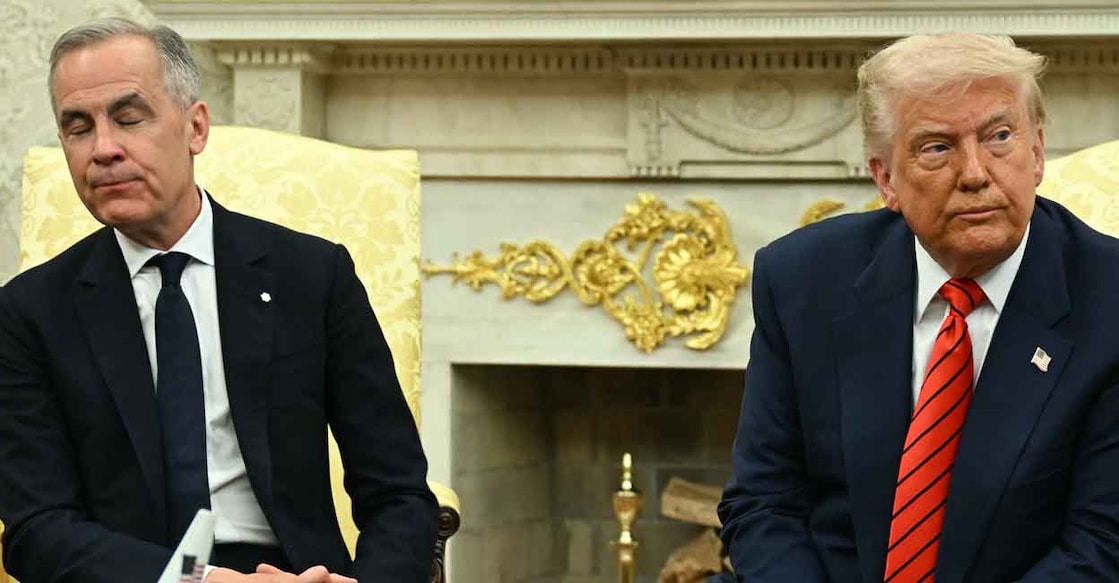Canada-US Drift: Sulking in the lasting romance

Mail This Article
Niagara Falls is one of the first things that comes to mind for a common Indian thinking about the USA and Canada – the mighty yet romantic natural wonder that lies on the border between the two countries. On one of my trips to see Niagara Falls from the US side, I was astonished to find a long row of restaurants – many of them Indian, but few, if any, American. Later, I realised that most of the tourists viewing the falls from the less attractive US side were foreign visitors. Most American tourists cross the border hassle-free, as if they were just visiting another town, to view the falls from the Canadian side.
It was hard to imagine anything different about these two ‘super friendly’ North American countries until now, but not anymore. Political and economic relations between these neighbours have become increasingly strained due to evolving dynamics within the continent itself. What makes even cool-headed Canadians furious are the unprecedented threats from their historically nice – but now 'super nasty' – big brother neighbour.
It all began in January when the president-elect, just before taking office, dropped a geopolitical bombshell: proposing that Canada become the 51st state of the United States. Amusing himself, Trump addressed the Canadian Prime Minister as ‘Governor of the great state of Canada,’ half-joking and half-serious.
Trump's 'crazy game' plan with Canada did not stop there; he continued to push provocative statements and policy proposals that were previously unheard of and unimaginable in the context of the historically fraternal US–Canada relationship.
During first day in the Oval Office, Trump mentioned his plans to impose a 25 percent tariff on imports from Canada and Mexico, even before his unilateral tariff measures against China. Additionally, the new US government imposed a 10 percent duty on Canadian energy imports.

Anti-Americanism
Writing a not-so-rosy story about Canada to Malayalis is no longer easy. Much like actor Sreenivasan’s iconic outburst in Sandesham –'Don’t talk about Poland!' – any pessimistic image of Canada can trigger emotional reactions.
The hopes and hard-earned money of countless families in today’s Kerala are deeply tied to their 'great' Canadian dreams. No community has bet bigger on Canada in recent years than Malayalis, drawn to the land of maple leaves, peace-loving people, and a rock-solid welfare state.
I recently received a call from an academic Malayali friend who was in Ottawa on a research stint. To my casual 'How are things in Canada?' came a swift and unexpected reply: 'Canadians hate the US like never before.'
With a mix of shock and surprise, he spoke about the widespread anti-American sentiment, even among ordinary people. Elderly Canadians at the shopping mall were asking billing staff whether items were made in America. It had become common to see deserted Starbucks and McDonald's outlets – US food chains that were once as popular in Canada as they were in the United States.
He even met a professor who was considering refueling his car in Canada before driving to the US for an academic conference –just to avoid contributing to the American economy!
Saying ‘no’ to American products and cross-border vacations has become something of a trend in Canada at the moment. For instance, Canadians are boycotting US wines, leading to significant losses for the globally renowned wine industry in California’s Napa Valley.
Reports suggest that Canadians are avoiding the iconic American entertainment capital, Las Vegas – not just because of trade tensions, but also due to the perceived disrespect shown by the US President toward their country.
The tariff war with major economies like Canada and China has already proven detrimental to the United States. In 2025, the US economy contracted by 0.3 per cent in the first quarter, compared to 2.4 per cent growth during the same period the previous year.

Shifting politics in Canada
In the past ten years, Canada has experienced an unparalleled wave of migration, unmatched by most other nations. Even from our small state of Kerala, countless young people have flocked to this North American promised land – nominally for education, but in reality, to secure jobs and establish permanent roots.
The surge in migration to Canada was directly driven by the pro-immigration policies of Justin Trudeau’s Liberal Party. Young students and middle-aged working-class individuals from countries like India –many of whom took loans or brought assets from home – had a palpable impact on the daily lives of Canadians. Real estate prices skyrocketed, forcing many citizens to relocate from cities like Toronto and Vancouver, resulting in longer commutes to work.
In addition, Canada’s lackluster economic performance triggered significant backlash against its immigration policy. Justin Trudeau’s popularity declined sharply, and support for the Liberal Party fell to just 16 per cent in January, shortly before the election. It became common to see cars with stickers reading ‘F— Trudeau’. Clear signs emerged that liberal-leaning Canada was shifting sharply to the right, echoing trends seen in many countries around the world.
However, things changed dramatically with the erratic unleashing of Trump's brand of 'craziness.' Replacing Trudeau, the Liberal Party placed its hopes in an anti-Trump firebrand economist – Mark Carney, the former central banker. Since Carney's rise to the Prime Minister's office, there has been a deliberate strategy to stir Canadian national pride vis-à-vis the United States.
“President Trump's unjustified tariffs come with threats to our sovereignty. They have one goal behind it. To weaken Canada, to break us, so that America can own us. To take our great strengths, our resources, our water, our land, our country. That will never happen.” declared the new Canadian Prime Minister in an election rally.
Time and again, this national leader delivers stirring speeches – rhetoric that powerfully evokes Winston Churchill’s iconic wartime declaration, 'We shall fight on the beaches…,' which once resounded through the House of Commons during World War II.
The Liberal Party's political project worked, and they returned to power under Mark Carney's leadership in the national elections held on 28 April. As The Guardian rightly puts it, the Liberal triumph is nothing short of a 'miraculous political resurrection', especially considering the sweeping Conservative victory that was predicted before the Trump factor surged.
Prime Minister Mark Carney stated that the old relationship Canada had with the United States, based on deepening economic integration and close security and military cooperation, was over, boldly signaling a break from the historic ties between the two nations.
Do the current developments in North America simply reflect a temporary sulking in the relationship between two nations that, until recently, were considered super loving?
End of an imagination?
For any Indian student of the last century, like me, learning from social science textbooks about North America fostered a unique imagination of friendly coexistence – despite the fact that the US and Canada share the world’s longest international boundary between two countries.
Our childhood notions of national boundaries were shaped by the steel-fenced India-Pakistan border, marked by frequent gunfire and episodes of cross-border terrorism. Decades later, little has changed – political violence remains a persistent reality in the subcontinent. The brutal Pahalgam massacre and the war-like situation following 'Operation Sindoor' are the most recent additions.
I still remember our geography teacher’s passionate excitement as she explained how the United States and Canada peacefully share the coveted Niagara Falls. Back then, it was fascinating to hear stories of a US and Canada so intimately connected that borders felt like little more than brief pauses – where drivers merely slowed down, flashed an ID, and moved on, as casually as passing through a toll booth.
How quickly a great North American dream and two of the world's most-heralded democracies devolved, as if they were just another pair of warring nations!
Can we imagine the specter of bullets ripping through the US-Canada border, shattering the timeless beauty of Niagara Falls?
After winning the election, Mark Carney has been making efforts to mend the strained relationship with the US. Earlier this week, the Canadian Prime Minister visited the White House to meet President Trump, who has begun to acknowledge the missteps of his tariff war. However, during their Oval Office meeting, President Trump shamelessly tried to justify – crazily invoking his 'artistic, real estate-style logic' – why Canada should join the United States. However, Prime Minister Carney categorically declared that Canada is 'not for sale' and will ‘never’ become part of the United States, though it remains open to partnership.
Hopefully, Niagara will continue to flow magnificently with its thunderous waterfalls – not with the shudders of gunfire.
(Social anthropologist and novelist Thomas Sajan and US-trained neurologist Titto Idicula, based in Norway, write on politics, culture, economy, and medicine)


